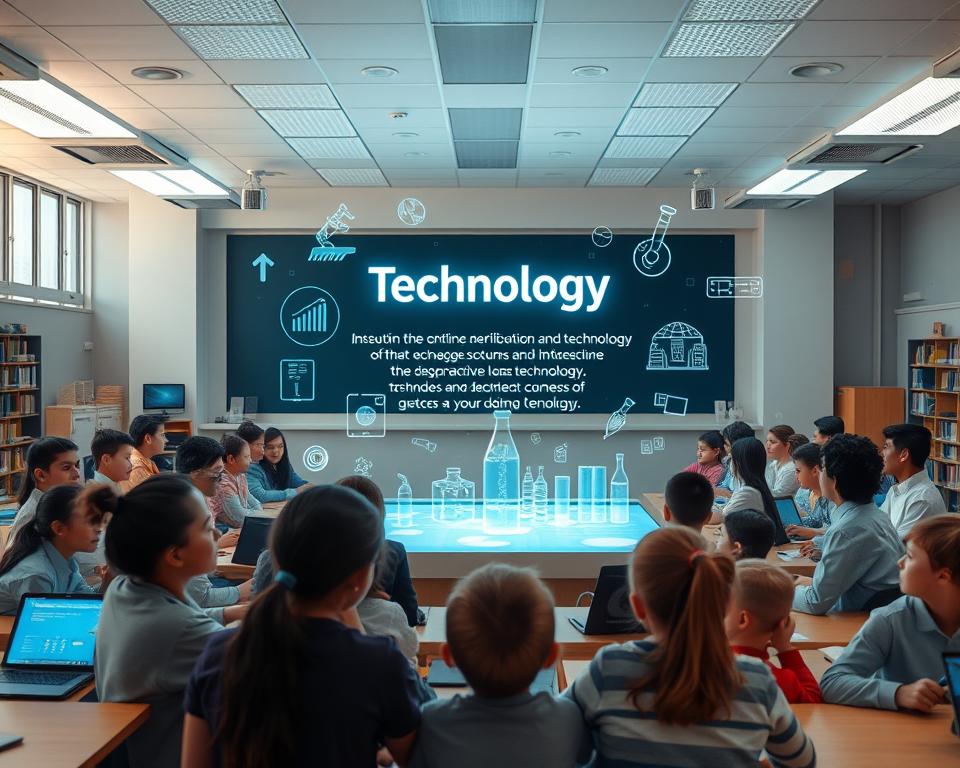
What is Technology? Definition for Students in Education
Did you know that according to a recent survey, over 90% of teachers believe that technology in education enhances student engagement? This remarkable figure underscores the critical role of technology in reshaping learning experiences. In the context of education, the definition of technology for students extends beyond just computers and tablets. It incorporates various tools, systems, and methodologies designed to elevate educational practices and improve learning outcomes. This means that educational technology is an essential element that transforms traditional classrooms into interactive and modern learning spaces that cater to diverse needs.

Key Takeaways
- The definition of technology for students includes tools and systems that enhance learning.
- Technology in education is essential for creating interactive learning environments.
- Educational technology assists in making learning more accessible and efficient.
- Engagement levels among students increase with the use of technology in classrooms.
- Understanding technology’s role in education is crucial for student success.
Understanding Technology in the Modern World
Technology in the modern world plays an essential role in shaping various aspects of everyday life. Rapid advancements introduce new tools and devices that transform how individuals communicate, work, and learn. This evolution has particularly impacted contemporary education technology, creating opportunities for more interactive and engaging learning experiences.
The digital divide underscores the importance of access to these technologies. While many benefit from advancements, others may lag behind due to limited resources or geographic constraints. Addressing this divide is crucial in ensuring equitable educational experiences for all students.
Modern educational paradigms increasingly incorporate technology, as educators recognize the need to adapt teaching methods to include digital competencies. Trends such as mobile learning empower students by providing accessible resources directly through their devices. The integration of artificial intelligence offers personalized learning experiences, allowing each learner to progress at their own pace.

Definition of Technology for Students in Education
Understanding technology within the educational context requires exploring various perspectives on its significance and application. Educators and theorists define technology as a collection of tools designed to enhance the learning experience. This definition emphasizes that technology, in its essence, supports knowledge acquisition and student engagement across different learning environments.
Exploring Common Definitions
Common definitions of technology often focus on its role as a facilitator of knowledge and skills. According to educational experts, technology encompasses both the hardware and software that assist in the learning process. This includes devices such as computers, tablets, and interactive tools that make learning more accessible and enjoyable. Educational theorist Seymour Papert noted that technology is a way to think differently about what learning can entail, allowing for more personalized educational experiences in various settings.
Technology in Everyday Life
Students interact with everyday technology in education more frequently than ever before, integrating tools like smartphones and online resources into their daily routines. These technologies bridge home and school environments, allowing learners to engage with educational content outside traditional settings. For instance, platforms like Google Classroom and educational apps facilitate continuous learning by providing resources that students can access anytime, anywhere. Understanding how these tools fit into the broader framework of education helps illuminate their importance in shaping young minds and enhancing their educational journeys.

| Type of Technology | Examples | Educational Benefits |
|---|---|---|
| Hardware | Smartphones, Tablets, Laptops | Accessibility, Engaged Learning |
| Software | Google Classroom, Kahoot, Zoom | Collaboration, Interactive Learning |
| Online Platforms | Coursera, Khan Academy, Quizlet | Resource Availability, Flexible Learning |
Types of Technology Used in Education
In today’s educational landscape, a variety of technologies play essential roles in enhancing the learning experience. Understanding the types of technology used in education can help educators and students maximize their potential. This section focuses on two significant categories: educational hardware and educational software.
Hardware and Devices
Educational hardware includes physical devices that assist in the teaching and learning processes. Common examples are:
- Computers: Essential for research, assignments, and communication.
- Tablets: Provide a portable solution for access to digital content.
- Interactive Whiteboards: Facilitate dynamic presentations and group work.
- Microphones and Cameras: Enhance remote learning and facilitate presentations.
These tools enable students to engage with the material in various ways, catering to different learning styles and needs.
Software and Applications
Educational software encompasses various programs and applications designed to support learning. Examples of this type include:
- Learning Management Systems (LMS): Streamline course management and student assessments.
- Educational Games: Make learning fun while reinforcing concepts.
- Classroom Management Tools: Help teachers organize lessons and assignments efficiently.
- Collaboration Platforms: Allow students and teachers to communicate in real-time.
Choosing the right educational software can enhance student engagement and effectively manage administrative tasks, ultimately contributing to a more organized and interactive learning environment.

Importance of Technology in Education
The importance of technology in education cannot be overstated. It plays a critical role in enhancing learning through technology. Students now benefit from diverse learning tools tailored to various educational needs. These advancements cater to individual learning styles, fostering an environment where everyone can thrive.
Technology has the potential to significantly improve student motivation. With interactive learning experiences, students engage more deeply with the content. Access to an abundance of resources creates opportunities for self-directed learning, encouraging students to explore subjects that interest them beyond the classroom walls.
Furthermore, technology equips students with essential 21st-century skills. It cultivates critical thinking and collaboration as students participate in group projects using digital tools. Such experiences empower students to communicate effectively and think analytically, preparing them for future challenges in a rapidly evolving world.
On a broader scale, technology bridges gaps in education. It provides access to materials and resources for students in underserved areas. Schools that embrace the importance of technology in education can create equitable learning environments, allowing all students to succeed regardless of their background.
| Benefits of Technology in Education | Details |
|---|---|
| Catering to Diverse Learning Styles | Technology offers various formats for learning, such as videos, interactive simulations, and reading materials. |
| Improving Student Motivation | Interactive tools and gamified learning increase engagement and enthusiasm among students. |
| Access to Information | The internet provides a wealth of resources that enhances learning and supports research. |
| Fostering Collaboration | Digital platforms enable students to work together, share ideas, and solve problems collaboratively. |
| Bridging Educational Gaps | Technology improves access to quality education for students in remote or underserved areas. |

Educational Technology Definition
Understanding the educational technology definition provides valuable insights into its transformative potential in learning environments. Educational technology encompasses the strategic use of tools, theories, and techniques to enrich teaching practices and foster student engagement. By applying these methods, educators can enhance their approaches, ultimately influencing the role of technology in learning.
The Role of Educational Technology
The role of educational technology in modern classrooms is pivotal. It enables personalized learning, which adapts to the unique needs of each student. This technology not only facilitates access to information but also allows for interactive experiences that promote critical thinking and collaboration among learners. Such engagement leads to a more profound understanding of subjects, supporting the overall objectives of educational institutions.
How It Differs from Traditional Methods
Traditional methods often rely on passive learning, where students absorb information through lectures and textbooks. In contrast, educational technology actively involves students in their learning processes, making education more dynamic. This shift encourages project-based, collaborative learning, moving away from rote memorization and fostering a deeper comprehension of material. By adopting these innovative strategies, educators create enriched learning experiences that resonate with today’s digital native students.
Technology Tools in the Classroom
In today’s educational landscape, technology tools in the classroom play a vital role in enhancing the learning experience. These tools not only make lessons more interactive but also help in organizing and managing coursework efficiently. Let’s explore a couple of essential tools that are transforming the educational environment.
Interactive Whiteboards and Projectors
Interactive whiteboards and projectors serve as effective interactive tools for learning. By facilitating dynamic presentations, they allow teachers to deliver multi-sensory lessons that capture students’ attention. Incorporating visuals and multimedia elements, these tools enable educators to present information in a manner that not only promotes engagement but also fosters better understanding among students.
Learning Management Systems (LMS)
Learning Management Systems play an essential role in contemporary education. These comprehensive platforms organize coursework, track student progress, and facilitate communication between teachers and students. By centralizing resources and assignments, LMS helps in creating streamlined pathways for learning, making it easier for students to engage with their educational material and track their achievements over time.
Digital Learning Resources Available Today
In today’s educational landscape, students and educators have access to a plethora of digital learning resources. These tools greatly enhance learning experiences and offer flexibility that traditional methods often lack. Among these resources, online courses and MOOCs represent a significant shift in how knowledge is shared and consumed.
Online Courses and MOOCs
Online courses provide an effective means for learners to engage with material at their own pace. Platforms like Coursera and edX offer Massive Open Online Courses (MOOCs) designed for diverse subjects and educational levels. These online courses cater to various learning styles, allowing individuals to access a range of content from reputable universities and institutions worldwide. Furthermore, students benefit from the convenience and ability to customize their learning paths.
E-books and Multimedia Resources
The emergence of e-books has transformed traditional reading. Digital texts not only allow for portability and easy access but also integrate multimedia for education, enriching the overall learning experience. Video tutorials, interactive simulations, and educational podcasts are excellent examples of multimedia resources that support comprehension and engagement. By offering information through various formats, educators can provide richer content that appeals to different preferences and needs.
Benefits of Technology in Learning
Technology has irrevocably changed the learning landscape, providing numerous benefits that enhance the educational experience. Focusing on *engagement through technology* reveals how modern tools and resources can captivate students and foster active participation. Furthermore, adaptive technologies create tailored educational experiences that cater to individual learning needs.
Enhancing Engagement and Participation
Innovative learning tools, such as interactive apps and online platforms, offer a dynamic and engaging way for students to absorb information. Gamification techniques turn traditional lessons into exciting challenges, motivating students to participate actively. Research indicates that when students engage with their learning materials through technology, their retention and understanding improve significantly.
Personalized Learning Experiences
The rise of adaptive learning technologies allows for a customized approach to education. These technologies collect data on student performance, enabling educators to adjust lessons according to each student’s strengths and weaknesses. This personalization fosters an environment where students feel valued and understood, ultimately enhancing their academic journey.
| Benefits | Examples | Impact on Learning |
|---|---|---|
| Increased Motivation | Gamified learning platforms | Higher student engagement |
| Customization | Adaptive learning software | Improved individual performance |
| Accessible Resources | Online libraries and databases | Expanded learning opportunities |
| Real-Time Feedback | Interactive quizzes | Quick identification of knowledge gaps |
Role of Technology in Student Success
The role of technology in student success cannot be overstated, as it significantly influences the learning experience. Interactive learning environments have emerged, enabling students to engage with materials in ways previously unimaginable. This engagement often leads to improved academic performance, creating a positive feedback loop that encourages further exploration and mastery of subjects.
Real-time assessments allow educators to gauge student understanding and adjust instruction accordingly. With technology at their fingertips, students can receive instant feedback on their performance, which helps them identify areas of improvement. The timely access to data enhances educational strategies and reinforces the *technology impact on performance*.
Furthermore, technology provides enhanced resources for struggling students. Tools such as educational apps and online tutoring services break down complex concepts and make learning more accessible. Research studies consistently show a positive correlation between increased technology use in education and enhanced learning outcomes. Educational technology serves as a bridge, connecting students with the support they need to succeed.
In summary, exploring the extensive role of technology in student success reveals a landscape rich with opportunities for learning. By facilitating engagement, offering real-time assessments, and providing additional resources, technology remains a crucial factor in enhancing educational experiences.
Challenges of Integrating Technology in Education
As schools increasingly adopt technology, they encounter several significant hurdles. One of the most pressing challenges of technology integration lies in addressing access and equity issues. Many disadvantaged communities struggle with a lack of essential resources, causing disparities in educational opportunities. Schools may have advanced technology, but some students lack access at home, widening the digital divide.
Another significant challenge involves the training of educators. Without proper instruction on how to effectively utilize technology tools, teachers may not maximize the potential benefits. Professional development must focus on equipping teachers with the skills necessary to integrate educational technology seamlessly into their classrooms. Addressing these training needs can help foster more equitable education environments, ensuring all students benefit from technology-enhanced learning experiences.
Best Practices for Technology Integration in Schools
Successfully implementing technology in education requires careful planning and ongoing support. Adopting best practices for technology integration can greatly enhance the learning environment in schools. Establishing a comprehensive approach to technology planning in schools ensures that educators and students are equipped to thrive in a digital age.
Developing a Technology Plan
A well-crafted technology plan is the cornerstone of effective technology integration. Schools should consider the following elements when creating their plans:
- Assessment of Current Infrastructure: Evaluate existing hardware, software, and network capabilities.
- Clear Goals and Objectives: Establish specific goals that align with educational outcomes.
- Budget Considerations: Allocate funds for both initial investments and ongoing maintenance.
- Involvement of Stakeholders: Engage teachers, administrators, parents, and students in the planning process.
Continuous Professional Development
Ongoing training for educators is vital to effectively utilize technology in the classroom. Regular professional development opportunities should include:
- Workshops and Training Sessions: Hands-on experiences to familiarize educators with new tools.
- Peer Collaboration: Creating a community of practice among educators to share insights and strategies.
- Access to Resources: Providing materials and support for continuous learning and skill enhancement.
- Feedback Mechanisms: Implementing systems for educators to share their experiences and suggestions for improvement.
Future Trends in Educational Technology
The landscape of education is evolving rapidly due to innovative advancements. A significant trend anticipated in the coming years involves the integration of artificial intelligence in personalized learning experiences. This technology will allow educators to tailor their approaches, addressing individual student needs more effectively.
Another exciting development is the increasing incorporation of virtual and augmented reality in classrooms. These immersive technologies promise to transform learning environments, offering students the chance to engage with content in new and interactive ways.
Online collaborative tools are also expected to advance, enhancing communication and teamwork among students, regardless of their physical location. These innovations represent some of the future trends in educational technology that educators and learners will likely embrace.
Below is a summary of the anticipated changes associated with emerging tech in education:
| Trend | Description | Benefits |
|---|---|---|
| Artificial Intelligence | Utilization of AI to personalize learning paths for students. | More effective learning tailored to individual needs. |
| Virtual & Augmented Reality | Creation of immersive learning experiences through VR/AR. | Enhanced engagement and understanding of complex subjects. |
| Online Collaboration Tools | Advanced platforms for student collaboration on projects. | Improved teamwork skills and connectivity among peers. |
Case Studies of Successful Technology Implementation
Exploring practical examples can provide valuable insights into successful technology implementation in educational settings. Various school districts have adopted innovative strategies to enhance learning, demonstrating tangible benefits for students and educators alike. These examples not only showcase effective practices but also highlight the journey of overcoming initial challenges.
Examples from Different School Districts
Several school districts offer compelling case studies in education, showcasing diverse approaches to integrating technology:
| School District | Technology Implemented | Challenges Faced | Outcomes Achieved |
|---|---|---|---|
| Cypress-Fairbanks ISD | Laptops for Students | Budget constraints, teacher training | Increased engagement, higher test scores |
| Chesterfield County Public Schools | Interactive Learning Software | Resistance to change | Improved collaboration, enhanced critical thinking |
| Waukesha School District | Flipped Classroom Model | Technology access disparities | Greater student autonomy, better time management |
| Fargo Public Schools | Virtual Reality Learning | Implementation logistics | Exciting experiences, deepened understanding of complex subjects |
These case studies illustrate how successful technology implementation can transform learning environments, fostering student growth and achievement. By examining real-world examples, other schools can adapt these strategies to meet their unique needs and contexts.
Parental Involvement in Technology Education
Parental involvement in education plays a critical role in shaping children’s learning experiences, especially in the realm of technology. As education increasingly embraces digital tools, parents can take proactive steps to support technology education for parents that directly benefits their children. Encouraging kids to use technology responsibly and effectively can lead to substantial academic success.
Communication between parents and teachers fosters a collaborative environment. Open dialogue about students’ use of technology in the classroom allows parents to reinforce learning at home. Many schools now offer workshops aimed at increasing parental engagement in technology education for parents. These sessions provide resources that empower parents to guide their children through digital landscapes.
Moreover, parents can enhance the learning experience by setting up structured tech time at home, allowing students to apply what they learn in school. In addition to academic support, parents can explore various educational apps and platforms together with their children. Engaging in these activities strengthens the relationship and ensures a deeper understanding of the tools being used in their education.
Evidence shows that when parents actively participate in their children’s technology-related education, student achievement tends to increase. This involvement often cultivates a sense of accountability, as children recognize the importance their parents place on learning. Through meaningful engagement, parents not only contribute to their children’s academic success but also foster a lifelong appreciation for technology.
Collaborative Learning Through Technology
In today’s educational landscape, collaborative learning with technology has become an essential component for fostering teamwork in education. Students can connect and collaborate on projects from different locations using various digital tools and platforms. This innovative approach allows them to engage with their peers in meaningful ways, transcending geographical barriers.
Collaborative platforms such as Google Workspace or Microsoft Teams empower students to work simultaneously on assignments, share resources, and communicate effectively. These tools not only enhance productivity but also encourage a culture of cooperation and shared responsibility among learners. Additionally, the use of discussion forums and virtual learning environments promotes a sense of community where students can offer support and feedback to one another.
Implementing collaborative learning with technology in the classroom leads to significant benefits, including the development of crucial social skills. Students learn to navigate group dynamics, resolve conflicts, and appreciate diverse perspectives. Such experiences prepare them for future teamwork in professional settings, making them more adaptable and effective collaborators in their careers.
Conclusion
In summary, the conclusion on technology in education highlights how educational technology has become a cornerstone of modern learning environments. The transformative power of technology continues to reshape pedagogical practices, effectively bridging gaps and enhancing accessibility for learners of all backgrounds. By integrating various technological tools and resources, educators can create dynamic learning experiences that cater to individual needs.
This educational technology overview underscores the endless possibilities that advancements bring to the classroom. From interactive learning platforms to customizable educational resources, technology empowers students to engage actively with their education in innovative ways. It is essential for educators and institutions to embrace these tools fully, fostering an environment that encourages exploration and creativity.
As we move forward, the call to action is clear: educators must continually seek opportunities to integrate technology effectively into their teaching methodologies. The future success of our educational system may significantly depend on our willingness to adapt and innovate in response to the ever-evolving technological landscape.



